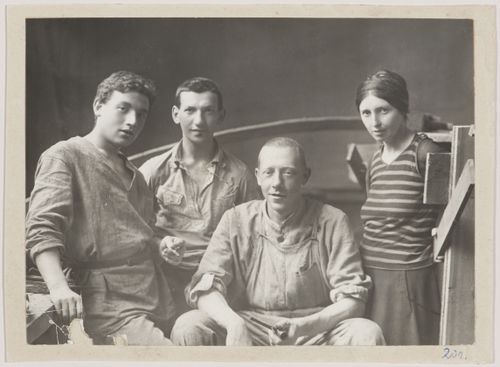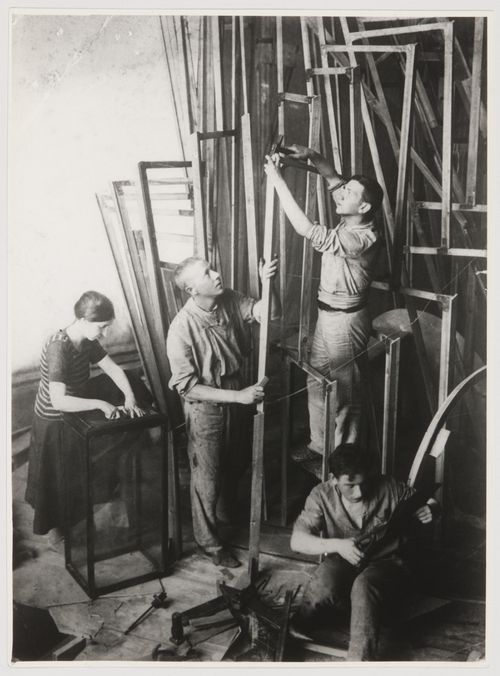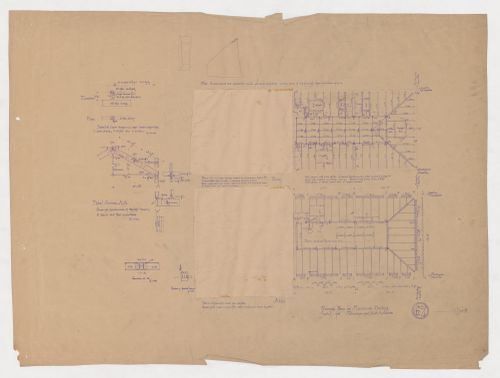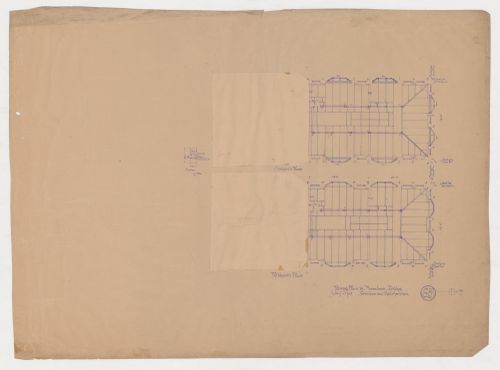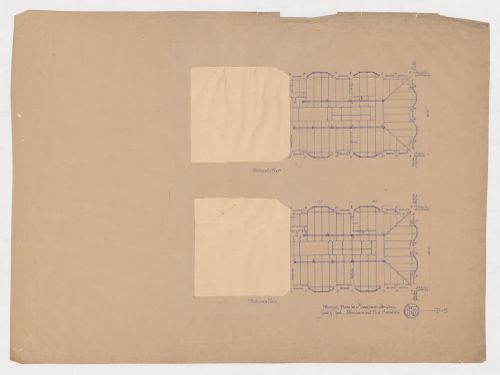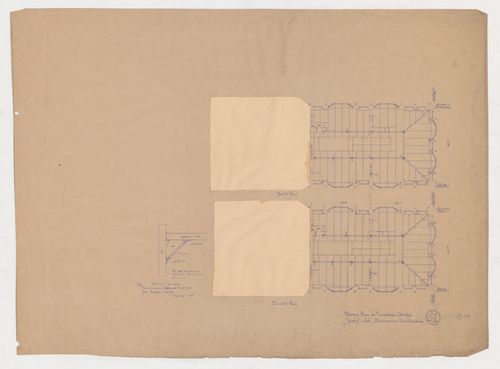Projet
Tumbleweeds Catcher (1972)
AP207.S1.1972.PR03
Description:
The project series documents "Tumbleweeds Catcher", an installation by Pettena and a group of his students from the University of Utah, in Salt Lake City, in 1972. The installation consisted of a tower-scaffold built on a vacant lot near the city centre and covered with mesh so it could capture the tumbleweeds blown by the wind. Through this installation Pettena's intention was to "highlight the 'work of the land', the tumbleweeds moved by the wind and intercepted by the mesh of the tower, 'naturalize' it, contaminate it, thereby embodying the revenge of nature over urbanized space." [1] A second edition was later presented at the Utah Museum of Contemporary Art in Salt Lake City in 2013. The project series contains photographs of the installation in 1972 and 2013, and drawings and sketches of the tower. Source: [1] Marco Scotini, editor. Non-conscious architecture: Gianni Pettena, Sternberg Press, 2018, 235 pages. p. 162.
circa 1972-2017
Tumbleweeds Catcher (1972)
Actions:
AP207.S1.1972.PR03
Description:
The project series documents "Tumbleweeds Catcher", an installation by Pettena and a group of his students from the University of Utah, in Salt Lake City, in 1972. The installation consisted of a tower-scaffold built on a vacant lot near the city centre and covered with mesh so it could capture the tumbleweeds blown by the wind. Through this installation Pettena's intention was to "highlight the 'work of the land', the tumbleweeds moved by the wind and intercepted by the mesh of the tower, 'naturalize' it, contaminate it, thereby embodying the revenge of nature over urbanized space." [1] A second edition was later presented at the Utah Museum of Contemporary Art in Salt Lake City in 2013. The project series contains photographs of the installation in 1972 and 2013, and drawings and sketches of the tower. Source: [1] Marco Scotini, editor. Non-conscious architecture: Gianni Pettena, Sternberg Press, 2018, 235 pages. p. 162.
Project
circa 1972-2017
Projet
AP207.S1.1986.PR01
Description:
The project series documents "Ombra", an installation presented for the first time at the Expo Arte of Galleria Speciale, in Bari, in 1986. It consists of an overcoat with flexible elements inserted in the lining of the fabric that form a structure to either create a seat for the wearer to sit on it or to stand on its own, if not worn. "So the multiplicity of roles, functions and subjects gives rise to an ambiguity, and a source of anxiety for he who, having conceived, made and “inhabited” it, perceives its more disquieting implications, those of an anomalous shadow, of another self that exists even in our absence." [1] The project series contains a sketch, photographs of the installation at the Galleria Speciale in 1986, a montage of film stills from Pettena's video explaining the installation, and digital versions of the installation film. Source: [1] Gianni Pettena website, https://www.giannipettena.it/italiano/opere-1/inst-armchair-1986/ (last accessed 11 December 2019).
circa 1985-2015
Ombra ["Shadow" Armchair] (1986)
Actions:
AP207.S1.1986.PR01
Description:
The project series documents "Ombra", an installation presented for the first time at the Expo Arte of Galleria Speciale, in Bari, in 1986. It consists of an overcoat with flexible elements inserted in the lining of the fabric that form a structure to either create a seat for the wearer to sit on it or to stand on its own, if not worn. "So the multiplicity of roles, functions and subjects gives rise to an ambiguity, and a source of anxiety for he who, having conceived, made and “inhabited” it, perceives its more disquieting implications, those of an anomalous shadow, of another self that exists even in our absence." [1] The project series contains a sketch, photographs of the installation at the Galleria Speciale in 1986, a montage of film stills from Pettena's video explaining the installation, and digital versions of the installation film. Source: [1] Gianni Pettena website, https://www.giannipettena.it/italiano/opere-1/inst-armchair-1986/ (last accessed 11 December 2019).
Project
circa 1985-2015
PH1993:0211
Description:
- This photograph shows Vladimir Tatlin (1885-1953) with three assistants from the "creative collective" which was organized so that he could continue work on the Monument to the Third International design while the model was being constructed (the model was completed for the third anniversary of the October Revolution, 7 November 1920). The assistants are (left to right): Iosif Aizikovich Meerzon (1900-1941), Tevel' Markovich Shapiro (1898-1984 or later), and Sofia Isaakovna Dymshits-Tolstaia (1888-1963).
architecture, portrait
between March and 7 November 1920
Group portrait of Vladimir Tatlin and his assistants I.A. Meerzon, T.M. Shapiro and S. Dymshits-Tolstaia at the time of the construction of the model for the Monument to the Third International, Petrograd (now Saint Petersburg)
Actions:
PH1993:0211
Description:
- This photograph shows Vladimir Tatlin (1885-1953) with three assistants from the "creative collective" which was organized so that he could continue work on the Monument to the Third International design while the model was being constructed (the model was completed for the third anniversary of the October Revolution, 7 November 1920). The assistants are (left to right): Iosif Aizikovich Meerzon (1900-1941), Tevel' Markovich Shapiro (1898-1984 or later), and Sofia Isaakovna Dymshits-Tolstaia (1888-1963).
architecture, portrait
PH1993:0213
Description:
- This photograph shows Vladimir Tatlin (1885-1953) with three assistants from the "creative collective" which was organized so that he could continue work on the Monument to the Third International design while the model was being constructed (the model was completed for the third anniversary of the October Revolution, 7 November 1920). The assistants are (left to right): Sofia Isaakovna Dymshits-Tolstaia (1888-1963), [Tatlin], Tevel' Markovich Shapiro (1898-1984 or later), and Iosif Aizikovich Meerzon (1900-1941).
architecture, portrait
between March and 7 November 1920
Vladimir Tatlin and his assistants S. Dymshits-Tolstaia, T.M. Shapiro and I.A. Meerzon constructing the first model for the monument to the Third International, Petrograd (now Saint Petersburg)
Actions:
PH1993:0213
Description:
- This photograph shows Vladimir Tatlin (1885-1953) with three assistants from the "creative collective" which was organized so that he could continue work on the Monument to the Third International design while the model was being constructed (the model was completed for the third anniversary of the October Revolution, 7 November 1920). The assistants are (left to right): Sofia Isaakovna Dymshits-Tolstaia (1888-1963), [Tatlin], Tevel' Markovich Shapiro (1898-1984 or later), and Iosif Aizikovich Meerzon (1900-1941).
architecture, portrait
Projet
AP207.S1.2017.PR02
Description:
The project series documents "Architecture Forgiven by Nature", an installation design by Pettena in 2017. The installation consists of an old water tower at the top of a hill in Brufa, covered with a metal grill. The intention is for plants to grow from the grill and hide the tower behind vegetation. The installation also included a staircase hidden behind the metal grill to give access to the top of the tower, so it could be used as a belvedere. "An additional function therefore joins the usual one, as nature helps to integrate a banal architecture into the landscape while also changing it into a place of consciousness and better understanding of both the environment and the art world." [1] The project is also known as "Torre di Brufa". The project series contains a drawing, printouts of digital renderings, plans of the structure surrounding the water tower, and video of Pettena showing the model of the tower. Source: [1] Gianni Pettena website, https://www.giannipettena.it/italiano/opere-1/nat-tower-in-brufa-2017/ (last accessed 28 January 2020)
2006-2017
Architecture Forgiven by Nature (2017)
Actions:
AP207.S1.2017.PR02
Description:
The project series documents "Architecture Forgiven by Nature", an installation design by Pettena in 2017. The installation consists of an old water tower at the top of a hill in Brufa, covered with a metal grill. The intention is for plants to grow from the grill and hide the tower behind vegetation. The installation also included a staircase hidden behind the metal grill to give access to the top of the tower, so it could be used as a belvedere. "An additional function therefore joins the usual one, as nature helps to integrate a banal architecture into the landscape while also changing it into a place of consciousness and better understanding of both the environment and the art world." [1] The project is also known as "Torre di Brufa". The project series contains a drawing, printouts of digital renderings, plans of the structure surrounding the water tower, and video of Pettena showing the model of the tower. Source: [1] Gianni Pettena website, https://www.giannipettena.it/italiano/opere-1/nat-tower-in-brufa-2017/ (last accessed 28 January 2020)
Project
2006-2017
Projet
AP056.S1.1984.PR01
Description:
This project series documents the interiors of the Marc Laurent store at 110 Bloor Street West in Toronto from 1984-1986. A project number assigned by the office is not identifiable. This project consisted of alterations to the interior of the high end retail store prior to the founding of KPMB, by Bruce Kuwabara and Thomas Payne. The design consisted of the removal and replacement of lighting fixtures, walls, change rooms and window displays. The project also included the design of a cash counter and new display furnishings such as mobile units, rack systems and a parallelogram unit. The rack system was made so that retail workers could easily reconfigure the design and locations of the racks based on merchandizing needs. Dark colours were used throughout the store including for the flooring, walls, and furnishings. The project is recorded through original drawings and a photograph dating from 1988 to around 1989. The drawings consist of a set of sections, plans, details for display and counter furnishings issued for construction, sketch plans, perspectives, and elevations. The photograph shows the finished interiors.
1986
Marc Laurent Store, Phase 1, Toronto (1984-1986)
Actions:
AP056.S1.1984.PR01
Description:
This project series documents the interiors of the Marc Laurent store at 110 Bloor Street West in Toronto from 1984-1986. A project number assigned by the office is not identifiable. This project consisted of alterations to the interior of the high end retail store prior to the founding of KPMB, by Bruce Kuwabara and Thomas Payne. The design consisted of the removal and replacement of lighting fixtures, walls, change rooms and window displays. The project also included the design of a cash counter and new display furnishings such as mobile units, rack systems and a parallelogram unit. The rack system was made so that retail workers could easily reconfigure the design and locations of the racks based on merchandizing needs. Dark colours were used throughout the store including for the flooring, walls, and furnishings. The project is recorded through original drawings and a photograph dating from 1988 to around 1989. The drawings consist of a set of sections, plans, details for display and counter furnishings issued for construction, sketch plans, perspectives, and elevations. The photograph shows the finished interiors.
Project
1986
DR1986:0767:048
Description:
- Twenty hectographs of the Monadnock Building were probably cut apart when the southern half, owned by Shepherd Brooks, became the Kearsarge Building in 1889 (DR1986:0767:120). The southern half of the building (DR1986:0767:466:001-042 and DR1986:0767:467:001-054) was cut out, leaving the northern half (DR1986:0767:048 - DR1986:0767:056, DR1986:0767:248 - DR1986:0767:257, and DR1986:0767:259). The hectographs were possibly divided so that two discrete sets of reprographic copies could be produced for the Monadnock and Kearsarge Buildings.
architecture, ingénierie
printed after 1889
Monadnock Building, Chicago: Framing plans with details for the roof and attic
Actions:
DR1986:0767:048
Description:
- Twenty hectographs of the Monadnock Building were probably cut apart when the southern half, owned by Shepherd Brooks, became the Kearsarge Building in 1889 (DR1986:0767:120). The southern half of the building (DR1986:0767:466:001-042 and DR1986:0767:467:001-054) was cut out, leaving the northern half (DR1986:0767:048 - DR1986:0767:056, DR1986:0767:248 - DR1986:0767:257, and DR1986:0767:259). The hectographs were possibly divided so that two discrete sets of reprographic copies could be produced for the Monadnock and Kearsarge Buildings.
architecture, ingénierie
DR1986:0767:049
Description:
- Twenty hectographs of the Monadnock Building were probably cut apart when the southern half, owned by Shepherd Brooks, became the Kearsarge Building in 1889 (DR1986:0767:120). The southern half of the building (DR1986:0767:466:001-042 and DR1986:0767:467:001-054) was cut out, leaving the northern half (DR1986:0767:048 - DR1986:0767:056, DR1986:0767:248 - DR1986:0767:257, and DR1986:0767:259). The hectographs were possibly divided so that two discrete sets of reprographic copies could be produced for the Monadnock and Kearsarge Buildings.
architecture, ingénierie
printed after 1889
Monadnock Building, Chicago: Fifteenth and sixteenth floor framing plans with sectional detail for beam-to-column connections
Actions:
DR1986:0767:049
Description:
- Twenty hectographs of the Monadnock Building were probably cut apart when the southern half, owned by Shepherd Brooks, became the Kearsarge Building in 1889 (DR1986:0767:120). The southern half of the building (DR1986:0767:466:001-042 and DR1986:0767:467:001-054) was cut out, leaving the northern half (DR1986:0767:048 - DR1986:0767:056, DR1986:0767:248 - DR1986:0767:257, and DR1986:0767:259). The hectographs were possibly divided so that two discrete sets of reprographic copies could be produced for the Monadnock and Kearsarge Buildings.
architecture, ingénierie
DR1986:0767:050
Description:
- Twenty hectographs of the Monadnock Building were probably cut apart when the southern half, owned by Shepherd Brooks, became the Kearsarge Building in 1889 (DR1986:0767:120). The southern half of the building (DR1986:0767:466:001-042 and DR1986:0767:467:001-054) was cut out, leaving the northern half (DR1986:0767:048 - DR1986:0767:056, DR1986:0767:248 - DR1986:0767:257, and DR1986:0767:259). The hectographs were possibly divided so that two discrete sets of reprographic copies could be produced for the Monadnock and Kearsarge Buildings.
architecture, ingénierie
printed after 1889
Monadnock Building, Chicago: Thirteenth and fourteenth floor framing plans
Actions:
DR1986:0767:050
Description:
- Twenty hectographs of the Monadnock Building were probably cut apart when the southern half, owned by Shepherd Brooks, became the Kearsarge Building in 1889 (DR1986:0767:120). The southern half of the building (DR1986:0767:466:001-042 and DR1986:0767:467:001-054) was cut out, leaving the northern half (DR1986:0767:048 - DR1986:0767:056, DR1986:0767:248 - DR1986:0767:257, and DR1986:0767:259). The hectographs were possibly divided so that two discrete sets of reprographic copies could be produced for the Monadnock and Kearsarge Buildings.
architecture, ingénierie
DR1986:0767:051
Description:
- Twenty hectographs of the Monadnock Building were probably cut apart when the southern half, owned by Shepherd Brooks, became the Kearsarge Building in 1889 (DR1986:0767:120). The southern half of the building (DR1986:0767:466:001-042 and DR1986:0767:467:001-054) was cut out, leaving the northern half (DR1986:0767:048 - DR1986:0767:056, DR1986:0767:248 - DR1986:0767:257, and DR1986:0767:259). The hectographs were possibly divided so that two discrete sets of reprographic copies could be produced for the Monadnock and Kearsarge Buildings.
architecture, ingénierie
printed after 1889
Monadnock Building, Chicago: Eleventh and twelfth floor framing plans with detail for the beam-to-column connections
Actions:
DR1986:0767:051
Description:
- Twenty hectographs of the Monadnock Building were probably cut apart when the southern half, owned by Shepherd Brooks, became the Kearsarge Building in 1889 (DR1986:0767:120). The southern half of the building (DR1986:0767:466:001-042 and DR1986:0767:467:001-054) was cut out, leaving the northern half (DR1986:0767:048 - DR1986:0767:056, DR1986:0767:248 - DR1986:0767:257, and DR1986:0767:259). The hectographs were possibly divided so that two discrete sets of reprographic copies could be produced for the Monadnock and Kearsarge Buildings.
architecture, ingénierie
